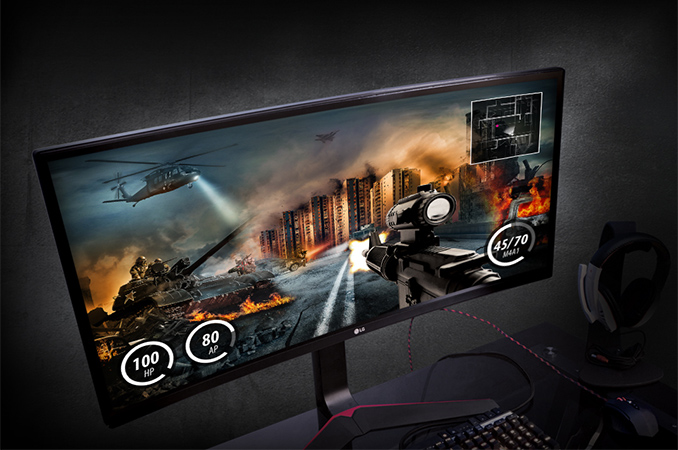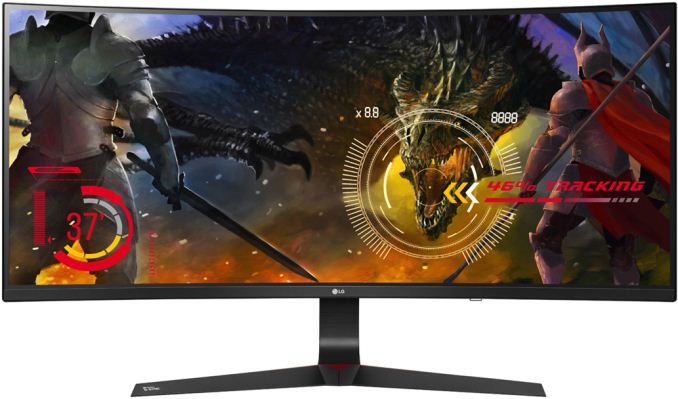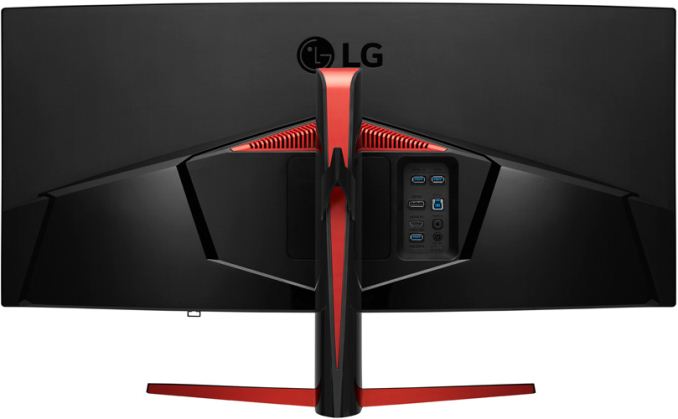LG’s 34UC89G 21:9 Curved Display with G-Sync, 144 to 166 Hz, Available for $999
by Anton Shilov on July 3, 2017 8:30 AM EST
LG has begun to sell its new ultra-wide curved display that appears to be its first monitor to support NVIDIA’s G-Sync technology. The LG 34UC89G resembles the 34UC79G display launched almost a year ago — it has a 21:9 aspect ratio, a 2560×1080 resolution and a native maximum refresh rate of 144 Hz. However, the new unit has a number of important differentiators when compared to the 34UC79G: its panel is listed as brighter, it can be overclocked, and it features G-SYNC. It also costs $300 more.
LG was an early adopter of AMD’s FreeSync back in early 2015 and since then it has launched numerous gaming displays featuring this technology. By contrast, the company has never released a monitor with NVIDIA’s G-Sync for an unknown reason. This summer LG finally decided to produce a G-Sync display and started with a model that has moderate characteristics by today’s standards. The LG UltraWide 34UC89G is outfitted with an IPS panel with a resolution of 2560×1080, a peak brightness of 300 nits, a contrast ratio of 1000:1, a 5ms GtG response time and 178° viewing angles. The panel has a native refresh rate of 144 Hz that can potentially be overclocked to 166 Hz, but that is not guaranteed. The new monitor looks like a re-engineered version of the 34UC79G, but given the fact that it has a different scaler (to enable G-Sync) and a panel that is 50 nits brighter and 166 Hz-capable, it seems to be a new display that shares chassis with one of its predecessors.
When it comes to connectivity, the LG UltraWide 34UC89G has a DisplayPort 1.2 and an HDMI 1.4 input, a dual-port USB 3.0 hub as well as a 3.5-mm audio jack. In some regions, the monitor may be equipped with two 7 W speakers (like the 34UC79G in Germany), but LG’s U.S. website does not mention them.
| LG UltraWide 34UC89G | |
| Panel | 34" IPS |
| Native Resolution | 2560 × 1080 |
| Refresh Rate | 144 Hz Overclockable to 166 Hz |
| Dynamic Refresh Rate Technology | NVIDIA G-Sync exact refresh rate range is unknown |
| Response Time | 5 ms gray-to-gray |
| Brightness | 300 cd/m² |
| Contrast | 1000:1 |
| Viewing Angles | 178°/178° horizontal/vertical |
| Pixel Pitch | 0.312 mm × 0.31 mm |
| Curvature | 3800R (?) |
| Anti-Glare Coating | Yes, 3H |
| Inputs | DisplayPort 1.2 for 2560×1080 at 144-166 Hz HDMI 1.4 for 2560×1080 at 60 Hz |
| USB Hub | 2-port USB 3.0 hub: two USB-A ports one supports fast charging |
| Audio | 3.5 mm audio jack 7 W × 2 (?) |
| Launch Price | $999 |
When LG released its 34UC79G last September, the combination of its features (IPS, curvature, a 144 Hz refresh rate and an ultra-wide aspect ratio) looked very compelling at a $699 price point. The situation is a bit different with the 34UC89G. The new monitor has the same 2560×1080 resolution and it costs $999.99 (likely due to G-Sync plus other factors). In the meantime, there is the Acer Predator Z35P 35” curved VA display offering a 3440×1440 resolution, a maximum refresh rate of 120 Hz (albeit via overclocking) and G-Sync available for $1099.99. The 34UC89G still has advantages - an IPS panel and a higher refresh rate.
The LG UltraWide 34UC89G is now available from various retailers worldwide, including Amazon and Newegg in the U.S.
Related Reading:
- LG Announces the 34UC79G: 34-Inch Curved 21:9 Display with 2560 × 1080 Resolution, 144 Hz Refresh Rate for $700
- AOC Launches the AG352QCX: 35-Inch 200 Hz 2560×1080 Curved Display with Adaptive-Sync
- Acer Predator X35 & ASUS ROG Swift PG35VQ Unveiled: 35-inch G-SYNC HDR Monitors - UltraWide, Curved, 200Hz
- Acer Predator Z35P Available for Order: Curved 35" with 3440×1440@120 Hz and G-Sync
- AOC Expands AGON Family with Curved AG322QCX and AG272FCX 144 Hz Displays
- AOC Announces the AGON AG352UCG 21:9 Curved Display: 35", 3440×1440, 100Hz with G-Sync
- HP Announces Omen X 35-Inch Curved Display for Gamers
Source: LG


















21 Comments
View All Comments
opticalBLADE - Saturday, August 12, 2017 - link
I have been all over the place on where I will go next. OLED would be preferred but is not an option. One of the ideas I had was to wait on those 4k Caddy monitors with all the bells and whistles from Acer and Asus, but the 144hz 4k QLED 27" HDT Gsync monitors wont be out until next year, so okay, fair enough. Another option would be the 35" offerings from both companies with the same specs but at 3880x1440 resolution and possible 200hz, but the question is, are those pushed back too? How much will a monitor with all that tech in it cost at release? When will volta cards be here to run them and how much will they be? I have a 980 ti so I really want to upgrade. I would try AMD but their embargoes are making me less anxious than I was months ago. There arent as many feature rich Freesync monitors with as many upgrade bullet points but its an instant 300 bucks price difference just to have Gsync, and I doubt one would notice even a 20 dollar difference in the adaptive sync technology, so the incentives are elsewhere. I am waiting to see what a few things are doing because theres just goign to be too many milestones met soon and I don't want to miss out or make a mistake at the price all this stuff costs, so the Samsung 32:9 3880x1080 is on my radar and I will definitely consider it and an AMD card if that big real estate isn't too pixel-y in 1080. The constant max frames, HDR, QLED, huge size and possibly big savings are very alluring. If the Nvidia camp doesn't price itself out the market then I am thinking the mid range Volta card paired with the 35in 1440 QLED HDR screens... really having a hard time justifying if the price for that experience is 2500 to 3k $$$. Good luck.Agent Smith - Monday, July 3, 2017 - link
Totally agree, you've covered everything i've been saying to friends for months.edzieba - Monday, July 3, 2017 - link
"I still don't understand what QLED is" It's a slight variant on LED backlighting: instead of using R, G and B LEDs, or using White LEDs, you use a single pure colour LED and a film that absorbs that colour and re-emits pure R, G and B. It's basically a way to make a wide gamut backlight more power efficent and slightly cheaper.StefanR - Saturday, July 8, 2017 - link
Yep, a 40" OLED 4k monitor with HDR please. I just ordered a pair of 1080ti's, I hope they're not outdated before a decent monitor comes around. Well, at least I can play every game at max quality settings...Btw, I think OLED monitors aren't here yet because of the lifespan of blue (wasn't it) OLED pixels ?
BenSkywalker - Tuesday, July 11, 2017 - link
That's only an issue for Samsung manufactured OLED panels. LG OLED panels use four white sub pixels three of which are coated in the corresponding color- R, G, B and W. They bought the patent for white OLEDs off of Kodak years ago in what people thought was insanely overpriced deal(retrospectively, not so much).https://www.google.com/patents/US7273663
LG OLEDs deteriorate at as close to perfectly evenly as you can get.
TLDR- Blue OLED sub pixels do die quicker, LG doesn't use them.
Kamamura - Wednesday, July 19, 2017 - link
What you talk about is white OLED used as a backlight together with LCD color filters - however, those will exhibit all the problems inherent to LCD displays - slow response time, problematic viewing angles. Moreover, the "white" OLED is not really white, so the gamut will be also poorer than in case of panels where the colors are generated by RGB emissive subpixels without any filtering.damianrobertjones - Monday, July 10, 2017 - link
It's VERY easy for them to get it right but as soon as they make a near perfect monitor... everyone buys and sales drop. 4k could be standard right now, with high refresh rates, with quality colours etc but that would reduce $$$$$$.The sooner tech sites call out this rubbish the better. At least Anandtech hasn't gone FULL Engadget/Verge on us. Yet.
Samus - Wednesday, July 5, 2017 - link
All things equal, why is this 2x more expensive than every other identical monitor except for the refresh rate?Hxx - Wednesday, July 5, 2017 - link
classic example of a perfectly fine looking monitor with all the features you would need except the resolution being set at a low end 1080p. Seriously LG...how much more cost to build an ultrawide 1440p ? even if that means 100hz i think most people would take a slightly lower refresh rate and 1440p then this,brubble - Thursday, July 6, 2017 - link
1k for a 1080p 34" monitor? BAHAHA.